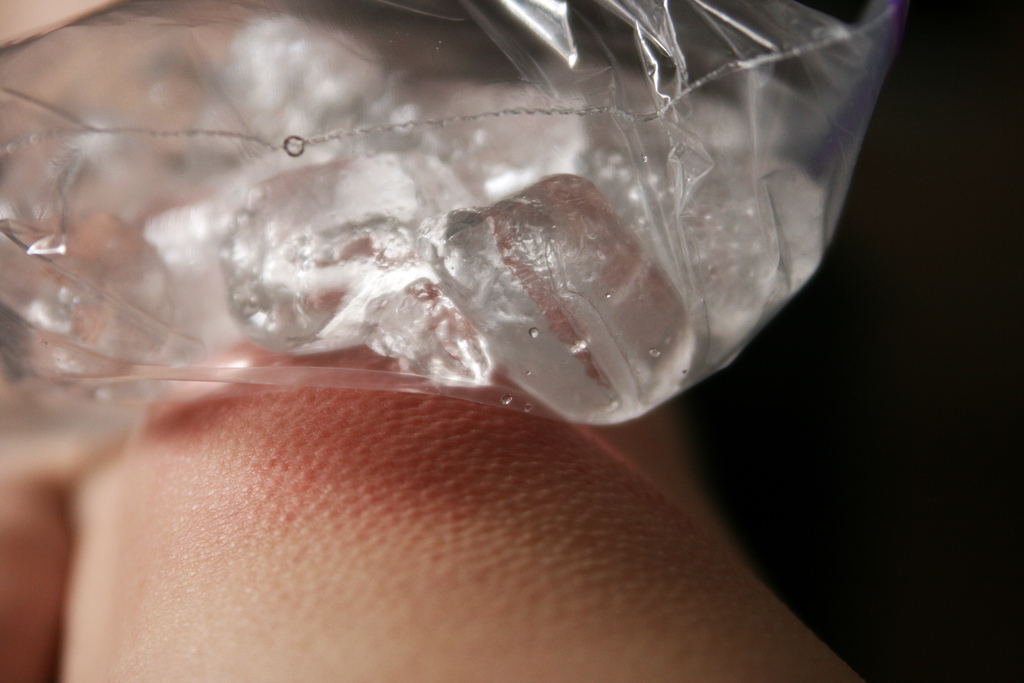
Is R.I.C.E Still the Answer for Musculoskeletal Injuries?
By Sheena Bhuva, MD and William Lian, MD
When I was growing up playing sports, there was never a shortage of ice in the training and locker rooms. The acronym R.I.C.E. (rest, ice, compression, elevation) with a particular emphasis on the “I” was thrown around for almost every injury I saw. Sprained your ankle playing basketball? R.I.C.E it! Injured your elbow after too many backhands in a tennis match? Try an ice massage! Strained your muscles after a gymnastics competition? Take a dip in the ice bath! The thought behind using R.I.C.E for musculoskeletal injuries was first introduced in 1978 by Dr. Gabe Mirkin in his best-selling book, The Sports Medicine Book. Until recently, ice had been the standard treatment for injuries, however now Dr. Mirkin himself is questioning whether ice is even beneficial.1 In fact, studies have recently been published that show ice can actually delay healing. Let’s take a closer look into why this is the case.
We know ice can help temporarily with pain by producing a localized numbing effect.2 But what about using ice to decrease inflammation? After an injury to soft tissue, such as an ankle sprain, the area becomes inflamed and swells. Some swelling from vessel dilation bringing blood flow to the area is good because this allows nourishment and healing of the injured tissue. On a very simple level, blood includes platelets and inflammatory responders such as hormones and growth factors that help heal tissue and deposit supporting structures (collagen). This is the idea behind PRP or platelet rich plasma injections used by sports medicine physicians including Desert Spine and Sports which are purported to help regenerate tendon tears and degrading cartilage. Our bodies therefore demonstrate an innate healing response to soft tissue injury. So perhaps the idea of using copious ice on an injured area which interrupts this natural inflammation may not really be a good one after all.
At one of our multi-disciplinary monthly journal clubs that includes physicians, physical therapists and other healthcare providers, we discussed a specific article that looked at the idea of icing sore muscles after a hard workout to promote recovery.3 Athletes were randomly split into two groups after a heavy eccentric triceps extension workout. Each group had either an ice pack or a sham pack applied to their sore arm muscles at 0, 3, 24, 48, and 72 hours after exercise. The athletes that used ice had evidence of higher levels of muscle injury (increased myoglobin and creatine kinase) after the workout as compared to the athletes who used sham ice packs. The authors concluded that using ice delays healing of exercise-induced muscle damage. Another study showed that ice delays our natural inflammatory response that provides hormones and healing factors which are essential for muscle repair.4
So if not R.I.C.E… then what? At our journal club, we discussed the modern-day answer to R.I.C.E, an acronym called P.O.L.I.C.E5 which stands for:
- Protection – Rest the injured area for a few days. Consider a crutch if needed.
- Optimal Loading – Start gentle passive range of motion while protecting the body part. This helps prevent muscle tightness and atrophy. Progress to active range of motion and then to strengthening exercises. Multiple studies show that early functional movement is better than complete rest.67
- Ice – Use ONLY if needed to decrease acute pain. Apply for a maximumof 10 minutes (any longer can cause permanent nerve damage or a freezer burn) with a 20 minute break. Repeat the 10-minute application of ice only 1-2 times. There is no reason to apply ice more than 6 hours after injury.
- Compression – Use an ACE bandage wrap. This helps the lymphatic vessels near the injured area clear waste and increase blood circulation. Avoid tubular bandages as they often provide non-uniform pressure and can create a tourniquet effect which restricts healthy blood flow. 8
- Elevation – Helps prevent excessive swelling that may impair range of motion.
So next time you have an acute musculoskeletal injury or are caring for others with sprains or strains, don’t think R.I.C.E. Allow the body to respond with its natural inflammatory response to promote healing, and follow instead the P.O.L.I.C.E principles. And let’s get back into the game – whether it be on the field, in the workplace, or in the home – quicker and safer than before!
Sources
1 http://www.drmirkin.com/fitness/why-ice-delays-recovery.html
5 https://www.verywell.com/the-police-principle-for-acute-sprains-and-strains-2696549
6 Bleakley, C. M., Glasgow, P. D., Phillips, N., Hanna, L., Callaghan, M. J., Davison, G. W. Hopkins, T. J., Delahunt, E. (2011). Management of acute soft tissue injury using protection rest ice compression and elevation: recommendations from the Association of Chartered Physiotherapists in sports and exercise medicine (ACPSM)[executive summary]. Association of Chartered Physiotherapists in Sports and Exercise Medicine, 1-24.
7 Kannus, P. (2000). Immobilization or early mobilization after an acute soft-tissue injury?. The physician and sportsmedicine, 28(3), 55-63.
8 Pollard A, Cronin G. Compression bandaging for soft tissue injury of the ankle: a literature review. Emerg Nurse. 2005;13(6):20-25. doi:10.7748/en2005.10.13.6.20.c1218
Images used under creative commons license – commercial use (1/19/2018) Quinn Dombrowski (Flickr)
